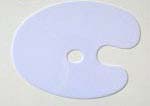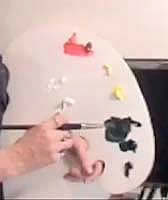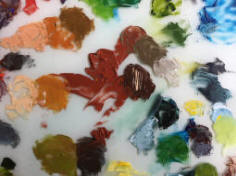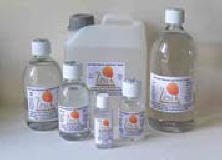
|
Palettes |

|
About Palettes for Oil Painting
| A large palette is not a necessity, but certainly a pleasure when it comes to mixing paint. Any palette after all, is your 'thinking ground', a place where you mix colours, judge their properties, make decisions, it needs to be comfortable to hold and suitable for the way you work. |
|
|
Wooden studio palettes
|
|
Acrylic and plastic palettes are easy to clean, the oil paint can be scraped off using a palette knife and the surface wiped. Greaseproof paper and tear-off palettes are easy to dispose of at the end of a painting session. |
 |
|
|
The type of palette is very much a personal choice, a large palette is very useful if you are standing at an easel, not so vital if you prefer to be seated. You can of course adapt any suitable surface as your palette, greaseproof paper, paper plate or butchers tray. If you are new to using a palette, try greaseproof paper first, it will give you an idea of how large a palette you need. |
|
|
 |
|
|
Cleaning the Palette Some people don't bother to clean the palette, leaving dried paint in hard ridged masses, adding new paint as required. Others clean the palette after each painting session, it's all a matter of personal choice and how you prefer to work. If you prefer to keep your palette clean, then scrape off the remains of the unused paint with a palette knife and wipe onto newspaper or paper towel. Wipe the palette with paper towel. Then wipe over with kitchen towel dipped in one of Zest-it products given below - a little goes a long way. Wipe and dry off the palette with paper towel, it will be clean and ready for use next time! |
|
|
 |
|
|
Hints and Tips A new wooden palette needs 'seasoning', apply a thin coat of Palette Oil to the surface and allow to dry. Repeat often. |
|
Zest-it Oil Paint Dilutant and Brush Cleaner not only for thinning paint, also for cleaning your palette, tools and brushes. |
 |
Products Brush Cleaning Brushes
Copyright 1999 - 2023 © J. & T. Blackman Ltd. All Rights Reserved Worldwide.
The information contained herein is the Intellectual Property of Jacqui Blackman and
J. & T. Blackman Ltd., and is supplied without liability for errors or omissions.
Zest-it ® and its logo are Registered Trademarks.
No part may be reproduced or used except as authorized by contract or other written permission, unless stated otherwise.
The copyright and the foregoing restriction on reproduction and use extend to all media in which the information may be embodied.![]()